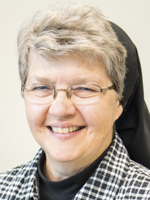
Sometimes imagining how the hundreds of groups which call themselves Christian might ever come together is as challenging as spilling out 1,000 pieces of a jigsaw puzzle and asking a family which has never done one to figure out how to put it together.
Yet that is what we are asked to do when it comes to finding commonalities with people of other faiths.
In ordinary circumstances, this Pentecost Sunday Mepkin Abbey would have been hosting a gathering of ministerial leaders from the Moncks Corner area. They would have shared prayer, song, and inspiration. The plans, which began with conversations last fall, fell victim to the uncertainties around COVID-19.
For a little more than five decades, Catholics have been actively engaged in dialogue, common prayer, and joint efforts on behalf of human dignity and outreach to the poor with their Christian brothers and sisters from Orthodox and Protestant traditions.
The Second Vatican Council, concluded in 1965, gave impetus to serious study, serious conversation, and some intensely productive agreements among the followers of Christ.
Twenty-five years ago, on the Solemnity of the Ascension, St. John Paul II urgently called us to pray and work even harder to achieve “full communion among Christ’s disciples.”
In many ways, ecumenism is not a new thing in our diocese. Bishop John England, during the first years of his travels around what was then a tri-state diocese, often received hospitality from Episcopalian, Methodist, Lutheran, and other Christian groups who allowed him to use their churches to gather the scattered Catholics.
John England was such a good friend of the civic community in Charleston that stories are still told of the prayers that were offered in churches and synagogues during his final illness and the bells that tolled all over the city when he died in 1842.
We’ve seen similar ecclesial hospitality in recent years, too. St. Gregory the Great and John Paul II schools have hosted the Holy Resurrection Greek Orthodox community. St. Mark Coptic Orthodox Church in Myrtle Beach let St. Elizabeth Ann Seton High School begin classes on their premises, and Okatee Baptist did the same for John Paul II School.
Our diocese has been very active with the Fellowship of South Carolina Bishops (formerly LARCUM), the South Carolina Christian Action Council, and Interfaith Partners of South Carolina.
With these groups, we have been able to do some of what John Paul II recommended. We have come together to honor God, to pray, and to join one another on behalf of an end to racism, advocating for quality education for all, an end to predatory lending, and care for God’s creation.
When John Paul II wrote the encyclical “Ut Unum Sint” (“That All May Be One”), he offered a reminder of the Lord’s desire for unity among believers, made clear in his Last Supper discourse. The positive steps he saw as making unity more possible were renewal, conversion, and reform.
In terms of renewal, he emphasized reclaiming the roots of our faith. That would entail careful examination of Sacred Scripture, the writings of the Fathers of the Church, and both the smaller traditions and the sacred tradition that has developed over centuries.
These help us see the points of convergence in our beliefs about the nature of Christ, the Trinity, salvation, sanctification, and so on.
We all know that we diverge significantly on a number of topics. Devotion to the Blessed Virgin Mary, the authority of the pope, purgatory, how we understand life issues and sexual ethics, the numbering and celebration of sacraments, what exactly happens when we celebrate the Eucharist, and eligibility for Holy Orders are among the most serious ones.
They are genuine — and often heartrending — hurdles.
Despite these hurdles, John Paul II believed that respectful dialogue could help all of our communities of faith not only renew but also experience a conversion of attitudes. Thus, what he advised was a stance of respectful listening and learning from one another. He also urged us to unite in prayer and in action on behalf of common concerns.
He spoke of how engagement with our fellow Christians can lead to “brotherhood rediscovered” — namely, the discovery that we hold more in common than we might have thought — and also “solidarity in the service of humanity.”
When he spoke of reform, St. John Paul II expressed a great hope that Christian people, led by the Holy Spirit, would achieve full communion sooner, rather than later, as we move through the first century of our present millennium.
One of the hopes he held out in terms of leadership was that the Bishop of Rome might be seen as exercising his role as “a universal ministry of Christian unity” and as the “servant of the servants of God.”
And then, of course, there is the matter of what we can do.
As events are rescheduled and gatherings become a bit easier, we can all look for opportunities to join people of various faiths in prayer and service.
Meanwhile we can be grateful that, even with our recent restrictions, numerous Zoom meetings, interactive webinars, and Facebook and YouTube postings were available. These included prayer for healing, Holy Week conversations, dialogue on Jewish-Christian relations, Earth Day remembrances, and so on.
As we go to press, this week will feature an online roundtable of bishops for “Laudato Si’ Week,” invitations for Christians to understand the Muslim celebration of Ramadan, and a weekly posting of prayers of thanksgiving and intercessions for basic needs focusing on one part of the world or another.
These are offered at www.oikoume ne.org. Connecting may help us put some pieces of the puzzle in place.

